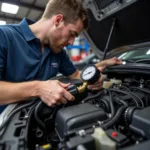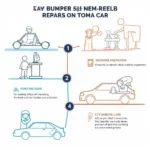Having a scratched car bumper is an unfortunate reality for many car owners. Whether it’s a minor scuff from a parking lot mishap or a deeper scratch from a fender bender, those blemishes can be an eyesore. Fortunately, you don’t always need a trip to the auto body shop to repair scratches on car bumper. This comprehensive guide will walk you through the different methods to effectively address those pesky scratches and restore your bumper’s appearance.
Assessing the Damage: What Kind of Scratch Do You Have?
Before diving into the repair process, it’s crucial to assess the severity of the scratch on your car bumper. The repair method you choose will depend on the depth and type of scratch you’re dealing with. Here are the three main categories:
-
Clearcoat Scratches: These are the most superficial scratches, affecting only the outermost layer of your car’s paint job, the clearcoat. They often appear as fine, white lines and can sometimes be buffed out with the right polishing compound.
-
Paint Scratches: These scratches go deeper than the clearcoat and expose the underlying paint layer. They’re usually noticeable as lighter or darker lines that reveal the color of the primer underneath. Repairing these scratches involves a bit more work, requiring touch-up paint and some sanding.
-
Deep Scratches: These are the most severe type of scratch, penetrating through the paint and primer, exposing the bare metal or plastic of the bumper. Deep scratches often require professional attention, especially if rust or significant damage to the bumper’s material has occurred.
DIY Repair Options for Minor Scratches
For minor clearcoat and paint scratches, several DIY repair options can effectively restore your bumper’s appearance without breaking the bank.
1. Using a Scratch Remover Product
Numerous scratch remover products are available on the market, ranging from rubbing compounds to specialized scratch removal kits. These products typically contain abrasive agents that gently buff away the scratch and level the surface.
How to Use:
- Clean the scratched area thoroughly with soap and water, then dry it completely.
- Apply a small amount of scratch remover product to a clean microfiber cloth.
- Gently rub the product onto the scratch using a circular motion, working your way outward from the center of the scratch.
- Continue rubbing until the scratch is no longer visible.
- Wipe away any excess product with a clean microfiber cloth.
2. Touch-Up Paint Method
For paint scratches that go through the clearcoat, touch-up paint is your best bet. You can purchase touch-up paint pens or bottles from your car’s manufacturer or an auto parts store.
How to Apply:
- Clean and dry the scratched area thoroughly.
- Shake the touch-up paint pen or bottle well to mix the paint.
- Using the applicator brush or pen tip, carefully dab the touch-up paint onto the scratch, ensuring you cover it entirely.
- Allow the paint to dry completely. Multiple thin coats are better than one thick coat to avoid paint runs.
- Once dry, you can use a polishing compound to blend the touch-up paint with the surrounding area for a seamless finish.
“When using touch-up paint, remember that patience is key,” advises John Smith, an experienced auto body specialist. “Applying multiple thin coats will yield a much better result than trying to cover the scratch with one heavy layer.”
When to Call a Professional
While DIY repairs can be effective for minor scratches, deeper scratches or those that have caused significant damage to the bumper material will require the expertise of a professional auto body shop. If you’re unsure about the severity of the scratch or your ability to repair it yourself, it’s always best to seek a professional opinion.
Here are some instances where professional repair is typically necessary:
- Deep scratches that expose the bare metal or plastic.
- Scratches that are accompanied by dents or cracks in the bumper.
- Scratches that show signs of rust.
- Scratches located in difficult-to-reach areas.
Preventing Future Bumper Scratches
Prevention is always better than cure. By taking a few precautionary measures, you can significantly reduce the risk of future scratches and keep your car bumper looking its best:
- Practice Safe Parking: Whenever possible, choose parking spots that are away from other vehicles and obstacles.
- Be Mindful of Tight Spaces: Be extra cautious when maneuvering in tight spaces like parking garages or drive-thrus.
- Consider Bumper Protectors: Bumper protectors, also known as bumper guards, can provide an extra layer of defense against minor bumps and scratches.
- Regular Washing and Waxing: Regular washing removes dirt and grime that can scratch your bumper, while waxing provides a protective layer against minor abrasions.
Conclusion
Repairing scratches on your car bumper doesn’t have to be a daunting task. By assessing the damage, choosing the appropriate repair method, and following the steps outlined above, you can restore your bumper’s appearance and keep your car looking its best. Remember, for deeper scratches or if you’re unsure about tackling the repair yourself, don’t hesitate to repair scratches on car plastic bumper by seeking professional help. Taking proactive steps to prevent future scratches will also go a long way in maintaining your car’s overall aesthetic appeal.



